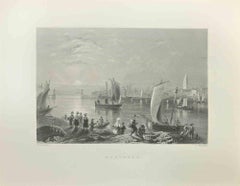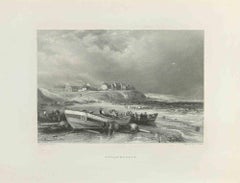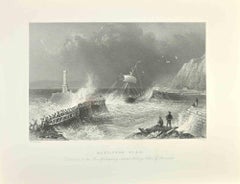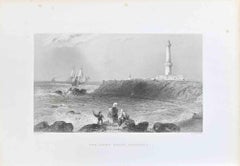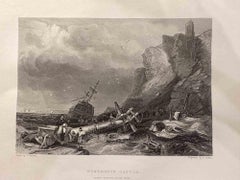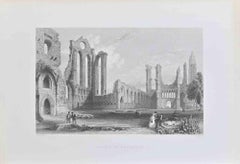Mid-19th Century Landscape Prints
to
22
710
204
29
17
2
Overall Width
to
Overall Height
to
509
19
11
5
3
1
93
48
34
22
18
1,016
2,091
9,937
4,107
117
117
689
515
588
1,113
1,475
1,729
1,297
599
657
705
256
1
585
205
181
126
121
93
91
80
78
73
62
62
52
51
49
48
45
42
39
34
647
189
123
103
60
66
705
406
262
Period: Mid-19th Century
Hontrose - Etching By W.H. Bartlett - 1845
Located in Roma, IT
Hontrose is an etching realized in 1845 by William Henry Bartlett.
Signed on the plate.
Titled on the lower center.
Good conditions with sli...
Category
Modern Mid-19th Century Landscape Prints
Materials
Etching
Cullercoats - Etching By George Balmer - 1845
Located in Roma, IT
Cullercoats is an etching realized in 1845 by George Balmer.
Signed on the plate.
Titled on the lower center.
Good conditions with slight foxing.
The artwork is beautifully real...
Category
Modern Mid-19th Century Landscape Prints
Materials
Etching
Mary- Port Pier - Etching By W.H. Bartlett - 1845
Located in Roma, IT
Mary- Port Pier is an etching realized in 1845 by W. H. Bartlett.
Signed on the plate.
Titled on the lower center.
Good conditions with slight foxing.
The artwork is beautifully...
Category
Modern Mid-19th Century Landscape Prints
Materials
Etching
The Light House, Aberdeen - Etching by W. H.Bartlett - 1845
Located in Roma, IT
The Light House, Aberdeen is an etching realized in 1845 by W. H. Bartlett.
Signed on the plate.
Titled on the lower center.
Good conditions with slight foxing.
The artwork is b...
Category
Modern Mid-19th Century Landscape Prints
Materials
Etching
Tynemouth Castel - Etching by Edward Francis Finden - 1845
Located in Roma, IT
Tynemouth Castel is an etching realized in 1845 by Edward Francis Finden.
Signed on the plate.
Titled on the lower center, from the series of "Ports of Great Britain"
The artwork...
Category
Modern Mid-19th Century Landscape Prints
Materials
Engraving, Etching
Abbey of Arbroath - Engraving by Thomas Higham - 1838
Located in Roma, IT
Abbey of Arbroath is an engraving on paper realized by T. Higham in 1838.
The artwork is in good condition.
The artwork is depicted in a well-balanced composition.
Category
Modern Mid-19th Century Landscape Prints
Materials
Engraving
Banff - Engraving by Robert Waths - 1838
Located in Roma, IT
Banff is an engraving on paper realized by R. Waths in 1838.
The artwork is in good condition.
The artwork is depicted in a well-balanced composition.
Category
Modern Mid-19th Century Landscape Prints
Materials
Engraving
Flamborough Head - Engraving by Edward Francis Finden - 1838
Located in Roma, IT
Flamborough Head is an engraving on paper realized by E.Finden in 1838.
The artwork is in good condition.
The artwork is depicted in a well-balanced composition.
Category
Modern Mid-19th Century Landscape Prints
Materials
Engraving
Harwich - Engraving by Edward Francis Finden - 1838
Located in Roma, IT
Harwich is an engraving on paper realized by E. Finden in 1838.
The artwork is in good condition.
The artwork is depicted in a well-balanced composition.
Category
Modern Mid-19th Century Landscape Prints
Materials
Engraving
Dundee - Engraving by Charles James Richardson - 1838
Located in Roma, IT
Dundee is an engraving on paper realized by C. Richardson in 1838.
The artwork is in good condition.
The artwork is depicted in a well-balanced composition.
Category
Modern Mid-19th Century Landscape Prints
Materials
Engraving
Hull - Engraving by Edward Francis Finden - 1838
Located in Roma, IT
Hull is an engraving on paper realized by W.Finden in 1838.
The artwork is in good condition.
The artwork is depicted in a well-balanced composition.
Category
Modern Mid-19th Century Landscape Prints
Materials
Engraving
Berwick - Engraving by Edward Francis Finden - 1838
Located in Roma, IT
Berwick Head is an engraving on paper realized by W.Finden in 1838.
The artwork is in good condition.
The artwork is depicted in a well-balanced composition.
Category
Modern Mid-19th Century Landscape Prints
Materials
Engraving
Meeting - Etching by Hégésippe Moreau - 1838
Located in Roma, IT
Meeting is a lithograph on paper realized by Hégésippe Moreau in 1838.
The artwork is in good condition.
Hégésippe Moreau (1810-1838) was a French l...
Category
Modern Mid-19th Century Landscape Prints
Materials
Engraving
The Quay, Yarmouth - Engraving by Edward Frencis Finden - 1845
Located in Roma, IT
The Quay, Yarmouth is an etching realized in the Early-20th Century by J.Sands.
Signed in plate.
The artwork is realized in a well-balanced composition.
Category
Modern Mid-19th Century Landscape Prints
Materials
Engraving
Yarmouth - Engraving by Edward Frencis Finden - 1845
Located in Roma, IT
Yarmouth is an etching realized in the Early-20th Century by E. Finden.
Signed in plate.
The artwork is realized in a well-balanced composition.
Category
Modern Mid-19th Century Landscape Prints
Materials
Engraving
Beaumaris - Etching by J.C.Armytage - 1845
Located in Roma, IT
Beaumaris is an etching realized in 1845 by J.C.Armytage.
Signed in plate.
The artwork is realized in a well-balanced composition.
Category
Modern Mid-19th Century Landscape Prints
Materials
Etching
St.Bees Head - Etching by J.C.Armytage - 1845
Located in Roma, IT
St.Bees Head is an etching realized in 1845 by W.Mosemann.
Signed in plate.
The artwork is realized in a well-balanced composition.
Category
Modern Mid-19th Century Landscape Prints
Materials
Etching
St.Bees College - Etching by J.C.Armytage - 1845
Located in Roma, IT
St.Bees College is an etching realized in 1845 by R. Wallis.
Signed in plate.
The artwork is realized in a well-balanced composition.
Category
Modern Mid-19th Century Landscape Prints
Materials
Etching
Whitehaven Harbour - Etching by J.C.Armytage - 1845
Located in Roma, IT
Whitehaven Harbour is an etching realized in the Early-20th Century by J.C.Armytage.
Signed in plate.
The artwork is realized in a well-balanced composition.
Category
Modern Mid-19th Century Landscape Prints
Materials
Etching
Port Penryn and Bagor - Etching by J.C.Armytage - 1845
Located in Roma, IT
Port Penryn and Bagor is an etching realized in 1845 by J.C.Armytage.
Signed in plate.
The artwork is realized in a well-balanced composition.
Category
Modern Mid-19th Century Landscape Prints
Materials
Etching
Conway Castle - Etching by J.C.Armytage - 1845
Located in Roma, IT
Conway Castle is an etching realized in 1845 by J.C. Armytage.
Signed in plate.
The artwork is realized in a well-balanced composition.
Category
Modern Mid-19th Century Landscape Prints
Materials
Etching
Dunstanborough Castle - Engraving by Edward Frencis Finden - 1845
Located in Roma, IT
Dunstanborough Castle is an engraving realized in 1845 by E.Finden.
Signed in plate.
The artwork is realized in a well-balanced composition.
Category
Modern Mid-19th Century Landscape Prints
Materials
Engraving
Dunstanborough Castle - Engraving by Edward Frencis Finden - 1845
Located in Roma, IT
Dunstanborough Castle is an engraving realized in 1845 by W.Finden.
Signed in plate.
The artwork is realized in a well-balanced composition.
Category
Modern Mid-19th Century Landscape Prints
Materials
Engraving
La Tour de L’Horloge (The Clock Tower, Paris)
Located in New York, NY
Charles Meryon (1821-1868), La Tour de L’Horloge (The Clock Tower, Paris), 1852, etching with engraving. Reference: Schneiderman 23, Delteil 28. Third state (of 10). On very thin Jap...
Category
Realist Mid-19th Century Landscape Prints
Materials
Engraving, Etching
Shere Mill Pond II (Large Plate)
Located in New York, NY
Seymour Haden (1818-1910), Shere Mill Pond II (Large Plate), etching and drypoint, 1860, signed in pencil lower right [also signed in the plate lower right]. Schneiderman 37, sixth state (of 9). In generally good condition (see note below) with margins, on a cream/ivory laid paper, 7 x 13 1/2, the sheet 8 1/8 x 13 3/4 inches.
A very good impression, with rich burr especially in the reeds toward the right.
Provenance: Frederick Keppel and Co., New York, NY.
Illustrated: Guichard, British...
Category
Impressionist Mid-19th Century Landscape Prints
Materials
Drypoint, Etching
'Victor's Camp - Hell Gate Ronde' original John Mix Stanley lithograph
Located in Milwaukee, WI
In the mid-nineteenth century, the United States government set out to survey and document its newly acquired lands and territories west of the Mississippi. The goals of these surveys were manifold: to produce topographical maps, to document flora and fauna, and to document natural resources to build the emerging US economy. These surveys, and the images from them, also functioned to build the new sense of American identity with the landscape, condensing vistas into the 'picturesque' tradition of European image making. Thus, the entire span of US territory could be seen as a single, cohesive whole.
This lithograph comes from one of six surveys commissioned by the Army's Topographic Bureau in 1853, which sought to find the best route to construct a transcontinental railroad. The result was a thirteen-volume report including maps, lithographs, and technical data entitled 'Explorations and Surveys to ascertain the most practicable and economical route for a Railroad from the Mississippi river to the Pacific Ocean.' In particular, the print comes from the northern survey, commanded by Isaac Stevens, which explored the regions between the 47th and 49th parallels.
Stanley shows here the stop the Stanley Party made at the junction of the Bitterroot and Hell Gate, in present day Montana. While there, the Party met with the Flathead Chief by the name Victor, as is shown in the image. The figures and their encampment are dwarfed by the vast landscape around them, indicating the sublimity of these new American territories.
5.75 x 8.75 inches, image
6.5 x 9.25 inches, stone
17 x 20 inches, frame
Artist 'Stanley Del.' lower left
Entitled 'Victor's Camp - Hell Gate Ronde' lower center margin
Publisher 'Sarony, Major & Knapp. Lith.s 449 Broadway N.Y.' lower right
Inscribed 'U.S.P.R.R. EXP. & SURVEYS — 47th & 49th PARALLELS' upper left
Inscribed 'GENERAL REPORT — PLATE XXXI' upper right
Framed to conservation standards using 100 percent rag matting with French accents; glazed with UV5 Plexiglas to inhibit fading; housed in a gold reverse ogee moulding.
Print in overall good condition; some localized foxing and discoloration; minor surface abrasions to frame.
John Mix Stanley...
Category
Romantic Mid-19th Century Landscape Prints
Materials
Lithograph
19th century color lithograph watercolor landscape figurative animal print
Located in Milwaukee, WI
The present hand-colored lithograph presents the viewer with a hunting scene in a picturesque landscape. In the foreground, a man approaches two partridges as his two pointers prepare to flush them out. Beyond, a white fence draws our eyes to the homestead in the distance. Images like this one show how people in the United States were trying to identify themselves as a new nation in the North American landscape - as separate from their European counterparts but with similar similar and specific wildlife and magesties of nature. It also identifies hunting in this landscape as an American pastime.
9.25 x 12.5 inches, artwork
18.38 x 22 inches, frame
Entitled bottom center "Partridge Shooting...
Category
Romantic Mid-19th Century Landscape Prints
Materials
Watercolor, Lithograph
Parade - Woodblock Print by Utagawa Kunisada - Mid-19th Century
Located in Roma, IT
Celebratory Parade is an original Woodcut print realized in mid 19th century after Utagawa Kunisada.
Good condition and Beautiful colored woodblock print.
This wonderful modern a...
Category
Modern Mid-19th Century Landscape Prints
Materials
Woodcut
The Unsafe Tenement
Located in New York, NY
James Abbot McNeill Whistler (1834-1903), The Unsafe Tenement, etching, 1858. [signed in the plate lower right]. References: Kennedy 17. Glasgow 18, fourth state (of four). In very good condition, printed on a very thin (two ply?) Japan paper, with margins, 6 1/8 x 8 3/4, the sheet 8 1/4 x 11, archival mounting.
A brilliant, black impression printed with astonishing clarity and exquisite detailing, on an ivory Japan paper. Presumably this is a proof impression before the relatively large edition published in this state (the edition was not on this paper).
Provenance: Inscribed “To Otto J. Schneider from his friend Frederick Keppel”. Schneider (1875-1946) was an American artist, noted for his realism, influenced by Whistler. Keppel was of course the well-known American dealer, one of whose specialties was Whistler prints. Keppel had a good relationship with Whistler until, as in most of his relationships, Whistler became inordinately troublesome – at which point Keppel wrote Whistler a longish, mocking poem, with lines such as these: “Like cackling hens or cocks a-crowing Your tireless trumpet keeps a-blowing. ” After this, Keppel wrote “at this point all my intercourse with this extraordinary man came to an end.”
(In the lower right is the ghost of another inscription, now erased, apparently to another friend from Edna (?) Schneider who presumably owned this print after Otto Schneider...
Category
Realist Mid-19th Century Landscape Prints
Materials
Etching
View of Bucarest - Original Lithograph - 1840
Located in Roma, IT
View of Bucarest is an Original Lithograph realized by an unknown artist in 1840.
The little artwork is in good condition.
No signature, title and dated.
Category
Modern Mid-19th Century Landscape Prints
Materials
Lithograph
19th century color lithograph portraits ship seascape patriotic flags military
Located in Milwaukee, WI
The present hand-colored lithograph is an excellent example of patriotic mid-nineteenth century American imagery. The print shows the battle and several of the major figures involved in the Battle of Lake Erie: At the center is a view of several frigates on the lake, embroiled in conflict. Above the battle is the quotation: "We have met the enemy and they are ours." Surrounding are laurel-lined roundels with portraits of Oliver Hazard Perry (1785-1819), Stephen Dicateur (1779-1820), Johnston Blakeley (1871-1814), William Bainbridge (1774-1833), David Porter (1780-1843), and James Lawrence (1781-1813) - all of these framed by American flags, banners and cannons. This print shows that the Battle of Lake Erie, part of the War of 1812, still held resonance for American audiences several decades later and was part of the larger narrative of the founding of the country.
9.5 x 13.5 inches, artwork
20 x 23.38 inches, frame
Entitled in the image
Signed in the stone, lower left "Lith. and Pub. by N. Currier"
Inscribed lower right "2 Spruce N.Y." and "No. 1"
Copyrighted lower center "Entered according to Act of Congress in the year 1846 by N. Currier in the Clerk's office of the Southern District of N.Y."
Framed to conservation standards using 100 percent rag matting and housed in a gold gilded moulding.
Nathaniel Currier was a tall introspective man with a melancholy nature. He could captivate people with his piercing stare or charm them with his sparkling blue eyes. Nathaniel was born in Roxbury, Massachusetts on March 27th, 1813, the second of four children. His parents, Nathaniel and Hannah Currier, were distant cousins who lived a humble yet spartan life. When Nathaniel was eight years old, tragedy struck. Nathaniel’s father unexpectedly passed away leaving Nathaniel and his eleven-year-old brother Lorenzo to provide for the family. In addition to their mother, Nathaniel and Lorenzo had to care for six-year-old sister Elizabeth and two-year-old brother Charles. Nathaniel worked a series of odd jobs to support the family, and at fifteen, he started what would become a life-long career when he apprenticed in the Boston lithography shop of William and John Pendleton.
A Bavarian gentleman named Alois Senefelder invented lithography just 30 years prior to young Nat Currier’s apprenticeship. While under the employ of the brothers Pendleton, Nat was taught the art of lithography by the firm’s chief printer, a French national named Dubois, who brought the lithography trade to America.
Lithography involves grinding a piece of limestone flat and smooth then drawing in mirror image on the stone with a special grease pencil. After the image is completed, the stone is etched with a solution of aqua fortis leaving the greased areas in slight relief. Water is then used to wet the stone and greased-ink is rolled onto the raised areas. Since grease and water do not mix, the greased-ink is repelled by the moisture on the stone and clings to the original grease pencil lines. The stone is then placed in a press and used as a printing block to impart black on white images to paper.
In 1833, now twenty-years old and an accomplished lithographer, Nat Currier left Boston and moved to Philadelphia to do contract work for M.E.D. Brown, a noted engraver and printer. With the promise of good money, Currier hired on to help Brown prepare lithographic stones of scientific images for the American Journal of Sciences and Arts. When Nat completed the contract work in 1834, he traveled to New York City to work once again for his mentor John Pendleton, who was now operating his own shop located at 137 Broadway. Soon after the reunion, Pendleton expressed an interest in returning to Boston and offered to sell his print shop to Currier. Young Nat did not have the financial resources to buy the shop, but being the resourceful type he found another local printer by the name of Stodart. Together they bought Pendleton’s business.
The firm ‘Currier & Stodart’ specialized in "job" printing. They produced many different types of printed items, most notably music manuscripts for local publishers. By 1835, Stodart was frustrated that the business was not making enough money and he ended the partnership, taking his investment with him. With little more than some lithographic stones, and a talent for his trade, twenty-two year old Nat Currier set up shop in a temporary office at 1 Wall Street in New York City. He named his new enterprise ‘N. Currier, Lithographer’
Nathaniel continued as a job printer and duplicated everything from music sheets to architectural plans. He experimented with portraits, disaster scenes and memorial prints, and any thing that he could sell to the public from tables in front of his shop. During 1835 he produced a disaster print Ruins of the Planter's Hotel, New Orleans, which fell at two O’clock on the Morning of the 15th of May 1835, burying 50 persons, 40 of whom Escaped with their Lives. The public had a thirst for newsworthy events, and newspapers of the day did not include pictures. By producing this print, Nat gave the public a new way to “see” the news. The print sold reasonably well, an important fact that was not lost on Currier.
Nat met and married Eliza Farnsworth in 1840. He also produced a print that same year titled Awful Conflagration of the Steamboat Lexington in Long Island Sound on Monday Evening, January 18, 1840, by which melancholy occurrence over One Hundred Persons Perished. This print sold out very quickly, and Currier was approached by an enterprising publication who contracted him to print a single sheet addition of their paper, the New York Sun. This single page paper is presumed to be the first illustrated newspaper ever published.
The success of the Lexington print launched his career nationally and put him in a position to finally lift his family up. In 1841, Nat and Eliza had their first child, a son they named Edward West Currier. That same year Nat hired his twenty-one year old brother Charles and taught him the lithography trade, he also hired his artistically inclined brother Lorenzo to travel out west and make sketches of the new frontier as material for future prints. Charles worked for the firm on and off over the years, and invented a new type of lithographic crayon which he patented and named the Crayola. Lorenzo continued selling sketches to Nat for the next few years.
In 1843, Nat and Eliza had a daughter, Eliza West Currier, but tragedy struck in early 1847 when their young daughter died from a prolonged illness. Nat and Eliza were grief stricken, and Eliza, driven by despair, gave up on life and passed away just four months after her daughter’s death.
The subject of Nat Currier’s artwork changed following the death of his wife and daughter, and he produced many memorial prints and sentimental prints during the late 1840s. The memorial prints generally depicted grief stricken families posed by gravestones (the stones were left blank so the purchasers could fill in the names of the dearly departed). The sentimental prints usually depicted idealized portraits of women and children, titled with popular Christian names of the day.
Late in 1847, Nat Currier married Lura Ormsbee, a friend of the family. Lura was a self-sufficient woman, and she immediately set out to help Nat raise six-year-old Edward and get their house in order. In 1849, Lura delivered a son, Walter Black Currier, but fate dealt them a blow when young Walter died one year later. While Nat and Lura were grieving the loss of their new son, word came from San Francisco that Nat’s brother Lorenzo had also passed away from a brief illness. Nat sank deeper into his natural quiet melancholy. Friends stopped by to console the couple, and Lura began to set an extra place at their table for these unexpected guests. She continued this tradition throughout their lives.
In 1852, Charles introduced a friend, James Merritt Ives, to Nat and suggested he hire him as a bookkeeper. Jim Ives was a native New Yorker born in 1824 and raised on the grounds of Bellevue Hospital where his father was employed as superintendent. Jim was a self-trained artist and professional bookkeeper. He was also a plump and jovial man, presenting the exact opposite image of his new boss.
Jim Ives met Charles Currier through Caroline Clark, the object of Jim’s affection. Caroline’s sister Elizabeth was married to Charles, and Caroline was a close friend of the Currier family. Jim eventually proposed marriage to Caroline and solicited an introduction to Nat Currier, through Charles, in hopes of securing a more stable income to support his future wife.
Ives quickly set out to improve and modernize his new employer’s bookkeeping methods. He reorganized the firm’s sizable inventory, and used his artistic skills to streamline the firm’s production methods. By 1857, Nathaniel had become so dependent on Jims’ skills and initiative that he offered him a full partnership in the firm and appointed him general manager. The two men chose the name ‘Currier & Ives’ for the new partnership, and became close friends.
Currier & Ives produced their prints in a building at 33 Spruce Street where they occupied the third, fourth and fifth floors. The third floor was devoted to the hand operated printing presses that were built by Nat's cousin, Cyrus Currier, at his shop Cyrus Currier & Sons in Newark, NJ. The fourth floor found the artists, lithographers and the stone grinders at work. The fifth floor housed the coloring department, and was one of the earliest production lines in the country. The colorists were generally immigrant girls, mostly German, who came to America with some formal artistic training. Each colorist was responsible for adding a single color to a print. As a colorist finished applying their color, the print was passed down the line to the next colorist to add their color. The colorists worked from a master print displayed above their table, which showed where the proper colors were to be placed. At the end of the table was a touch up artist who checked the prints for quality, touching-in areas that may have been missed as it passed down the line. During the Civil War, demand for prints became so great that coloring stencils were developed to speed up production.
Although most Currier & Ives prints were colored in house, some were sent out to contract artists. The rate Currier & Ives paid these artists for coloring work was one dollar per one hundred small folios (a penny a print) and one dollar per one dozen large folios. Currier & Ives also offered uncolored prints to dealers, with instructions (included on the price list) on how to 'prepare the prints for coloring.' In addition, schools could order uncolored prints from the firm’s catalogue to use in their painting classes.
Nathaniel Currier and James Merritt Ives attracted a wide circle of friends during their years in business. Some of their more famous acquaintances included Horace Greeley, Phineas T. Barnum, and the outspoken abolitionists Rev. Henry Ward, and John Greenleaf Whittier (the latter being a cousin of Mr. Currier).
Nat Currier and Jim Ives described their business as "Publishers of Cheap and Popular Pictures" and produced many categories of prints. These included Disaster Scenes, Sentimental Images, Sports, Humor, Hunting Scenes, Politics, Religion, City and Rural Scenes, Trains, Ships, Fire Fighters, Famous Race Horses, Historical Portraits, and just about any other topic that satisfied the general public's taste. In all, the firm produced in excess of 7500 different titles, totaling over one million prints produced from 1835 to 1907.
Nat Currier retired in 1880, and signed over his share of the firm to his son Edward. Nat died eight years later at his summer home 'Lion’s Gate' in Amesbury, Massachusetts. Jim Ives remained active in the firm until his death in 1895, when his share of the firm passed to his eldest son, Chauncey.
In 1902, faced will failing health from the ravages of Tuberculosis, Edward Currier sold his share of the firm to Chauncey Ives...
Category
Victorian Mid-19th Century Landscape Prints
Materials
Watercolor, Lithograph
Grotte à Elephanta - Original Lithograph by Jacob Rudisuhli - 19th Century
Located in Roma, IT
Grotte à Elephanta is an original modern artwork realized by Jacob Rudisuhli (1835-1918) in the late 19th Century.
Original B/W Lithograph on Ivory Paper.
Inscripted on the lower ...
Category
Modern Mid-19th Century Landscape Prints
Materials
Lithograph
View of the Ponte della Santa Trinità - Etching by Thomas Lupton- 1833
Located in Roma, IT
Views of the Ponte della Santa Trinità is an original artwork realized by Thomas Lupton (1791-1873) in 1833.
Original etching.
In the lower central part there is the inscription "p...
Category
Modern Mid-19th Century Landscape Prints
Materials
Etching
View of Vallombrosa - Etching by Thomas Lupton - 1833
Located in Roma, IT
View of Vallombrosa (ancient name: Valombrosa) is an original artwork realized by Thomas Lupton (1971-1873) in 1833.
Original etching.
In the lower central part there is the inscri...
Category
Modern Mid-19th Century Landscape Prints
Materials
Etching
Ancient View of Florence - Original Lithograph - 1850 ca.
Located in Roma, IT
Florenz is an original modern artwork realized in Italy in the first half of the 19th Century.
Original Lithograph on Ivory Paper.
Inscripted on the lower margin in Capital Lette...
Category
Modern Mid-19th Century Landscape Prints
Materials
Lithograph
Der Triumpfbogen de L'Etoile - Original Lithograph - Mid-19th Century
Located in Roma, IT
Der Triumpfbogen de L'Etoile is an original modern artwork realized in the Mid-19th Century.
Original B/W Lithograph on Ivory Paper.
Inscripted on the lower central margin in Capi...
Category
Modern Mid-19th Century Landscape Prints
Materials
Lithograph
Strasburg - Original Lithograph - Mid-19th Century
Located in Roma, IT
Strasburg is an original modern artwork realized in the Mid-19th Century.
Original B/W Lithograph on Ivory Paper.
Inscripted on the lower central margin in Capital Letters: Strasb...
Category
Modern Mid-19th Century Landscape Prints
Materials
Lithograph
Ancient View of Birmingham - Original Lithograph - Mid-19th Century
Located in Roma, IT
Ancient View of Birmingham is an original modern artwork realized in the Mid-19th Century.
Original B/W Lithograph on Ivory Paper.
Inscripted on the lower central margin in Capita...
Category
Modern Mid-19th Century Landscape Prints
Materials
Lithograph
The Canongate - Original Lithograph - 1822
Located in Roma, IT
The Canongate is an original artwork realized in 1822.
Original B/W Lithograph on Ivory Paper.
Inscripted on the lower central margin in Capital Letters: The Canongate durng the p...
Category
Modern Mid-19th Century Landscape Prints
Materials
Lithograph
Ancient Eaton Hall, Cheshire - Original Lithograph - Mid-19th Century
Located in Roma, IT
Eaton Hall, Cheshire is an original modern artwork realized in the Mid-19th Century.
Original B/W Lithograph on Ivory Paper.
Inscripted on the lower cent...
Category
Modern Mid-19th Century Landscape Prints
Materials
Lithograph
Lowther Castle - Original Lithograph - Mid-19th Century
Located in Roma, IT
Lowther Castle is an original modern artwork realized in the Mid-19th Century.
Original B/W Lithograph on Ivory Paper.
Inscripted on the lower central margin in Capital Letters: L...
Category
Modern Mid-19th Century Landscape Prints
Materials
Lithograph
Ancient View of Oxford - Original Lithograph - Mid-19th Century
Located in Roma, IT
Ancient View of Oxford is an original modern artwork realized in the Mid-19th Century.
Original B/W Lithograph on Ivory Paper.
Inscripted on the lower central margin in Capital Le...
Category
Modern Mid-19th Century Landscape Prints
Materials
Lithograph
Ancient View of Oxford - Original Lithograph - Mid-19th Century
Located in Roma, IT
Ancient View of Oxford is an original modern artwork realized in the Mid-19th Century.
Original B/W Lithograph on Ivory Paper.
Inscripted on the lower central margin in Capital Le...
Category
Modern Mid-19th Century Landscape Prints
Materials
Lithograph
Ancient View of Havre - Original Lithograph - Mid-19th Century
Located in Roma, IT
Ancient View of Havre is an original modern artwork realized in the Mid-19th Century.
Original B/W Lithograph on Ivory Paper.
Inscripted on the lower central margin: Havre.
Total...
Category
Modern Mid-19th Century Landscape Prints
Materials
Lithograph
Chamouni in der Schweiz - Original Lithograph - Mid-19th Century
Located in Roma, IT
Chamouni in der Schweiz is an original modern artwork realized in the Mid-19th Century.
Original B/W Lithograph on Ivory Paper.
Inscripted on the lower central margin in capital l...
Category
Modern Mid-19th Century Landscape Prints
Materials
Lithograph
Gullo Fall - Original Lithograph - Mid-19th Century
Located in Roma, IT
Gullo Fall is an original modern artwork realized in Germany in the Mid-19th Century.
Original B/W Lithograph on Ivory Paper.
Inscripted on the lower central margin in Capital Let...
Category
Modern Mid-19th Century Landscape Prints
Materials
Lithograph
Gullo Fall - Original Lithograph - Mid-19th Century
Located in Roma, IT
Gullo Fall is an original modern artwork realized in Germany in the Mid-19th Century.
Original Colored Lithograph on Ivory Paper.
Inscripted on the lower central margin in Capital...
Category
Modern Mid-19th Century Landscape Prints
Materials
Lithograph
Ancient View of Ajaccio - Lithograph - Mid-19th Century
Located in Roma, IT
Ajaccio is an original modern artwork realized in the Mid-19th Century.
Original B/W Lithograph on Ivory Paper.
Inscripted on the lower central margin in Capital Letters: Ajaccio....
Category
Modern Mid-19th Century Landscape Prints
Materials
Lithograph
Der Tuillerien-Pallast - Original Lithograph - Mid-19th Cent
Located in Roma, IT
Der Tuillerien-Pallast is an original modern artwork realized in the Mid-19th Century.
Original B/W Lithograph on Ivory Paper.
Inscripted on the lower central margin in Capital Le...
Category
Modern Mid-19th Century Landscape Prints
Materials
Lithograph
Howard Castle - Original Lithograph - Mid-19th Century
Located in Roma, IT
Howard Castle is an original modern artwork realized in the Mid-19th Century.
Original B/W Lithograph on Ivory Paper.
Inscripted on the lower central margin in Capital Letters: Ho...
Category
Modern Mid-19th Century Landscape Prints
Materials
Lithograph
Das Stasthaus in Paris - Original Lithograph - Mid-19th Cent
Located in Roma, IT
Das Stasthaus in Paris is an original modern artwork realized in the Mid-19th Century.
Original B/W Lithograph on Ivory Paper.
Inscripted on the lower central margin in Capital Le...
Category
Modern Mid-19th Century Landscape Prints
Materials
Lithograph
Tyningame House, Haddington - Original Lithograph - Mid-19th Century
Located in Roma, IT
Tyningame House, Haddington is an original modern artwork realized in the Mid-19th Century.
Original B/W Lithograph on Ivory Paper.
Inscripted on the lower central margin in Capit...
Category
Contemporary Mid-19th Century Landscape Prints
Materials
Lithograph
The Ancient "Wishing-Gate" - Original Lithograph - Mid-19th Cent
Located in Roma, IT
The Ancient "Wishing-Gate", Liverpool is an original modern artwork realized in the Mid-19th Century.
Original B/W Lithograph on Ivory Paper.
Inscripted on the lower central margi...
Category
Modern Mid-19th Century Landscape Prints
Materials
Lithograph
Anciens Monuments Sepuloraua de l'Alsace - Original Lithograph - Mid-19th Cent
Located in Roma, IT
Anciens Monuments Sepuloraua de l'Alsace is an original modern artwork realized in the Mid-19th Century.
Original B/W Lithograph on Ivory Paper.
Inscripted on the lower central ma...
Category
Modern Mid-19th Century Landscape Prints
Materials
Lithograph
The Quay Waterford - Original Lithograph - Mid-19th Century
Located in Roma, IT
The Quay Waterford is an original modern artwork realized in Germany in the Mid-19th Century.
Original B/W Lithograph on Ivory Paper.
Inscripted on the lower central margin: The Q...
Category
Modern Mid-19th Century Landscape Prints
Materials
Lithograph
Ancient View of the Dublin Bay - Original Lithograph - Mid-19th Century
Located in Roma, IT
Ancient View of the Dublin Bay is an original modern artwork realized in Germany in the Mid-19th Century.
Original B/W Lithograph on Ivory Paper. ...
Category
Contemporary Mid-19th Century Landscape Prints
Materials
Lithograph
Fahlun-Minen - Original Lithograph - Mid-19th Century
Located in Roma, IT
Fahlun-Minen is an original modern artwork realized in Germany in the Mid-19th Century.
Original B/W Lithograph on Ivory Paper.
Inscripted on the lower central margin in Capital L...
Category
Modern Mid-19th Century Landscape Prints
Materials
Lithograph
Galnay - Original Lithograph - Mid-19th Century
Located in Roma, IT
Galnay is an original modern artwork realized in Germany in the Mid-19th Century.
Original B/W Lithograph on Ivory Paper.
Inscripted on the lower central margin: Galnay (from the ...
Category
Modern Mid-19th Century Landscape Prints
Materials
Lithograph
Ancient View of Trapani - Original Lithograph - Mid 19th Century
Located in Roma, IT
Trapani is an original modern artwork realized in Germany in the Mid-19th Century.
Original B/W Lithograph on Ivory Paper.
Inscripted on the lower central margin in Capital Letter...
Category
Modern Mid-19th Century Landscape Prints
Materials
Lithograph
Die Fingals - Höhle - Original Lithograph - Mid 19th Century
Located in Roma, IT
Die Fingals - Höhle is an original modern artwork realized in Germany in the Mid-19th Century.
Original B/W Lithograph on Ivory Paper.
Inscripted on the lower central margin in Ca...
Category
Modern Mid-19th Century Landscape Prints
Materials
Lithograph
